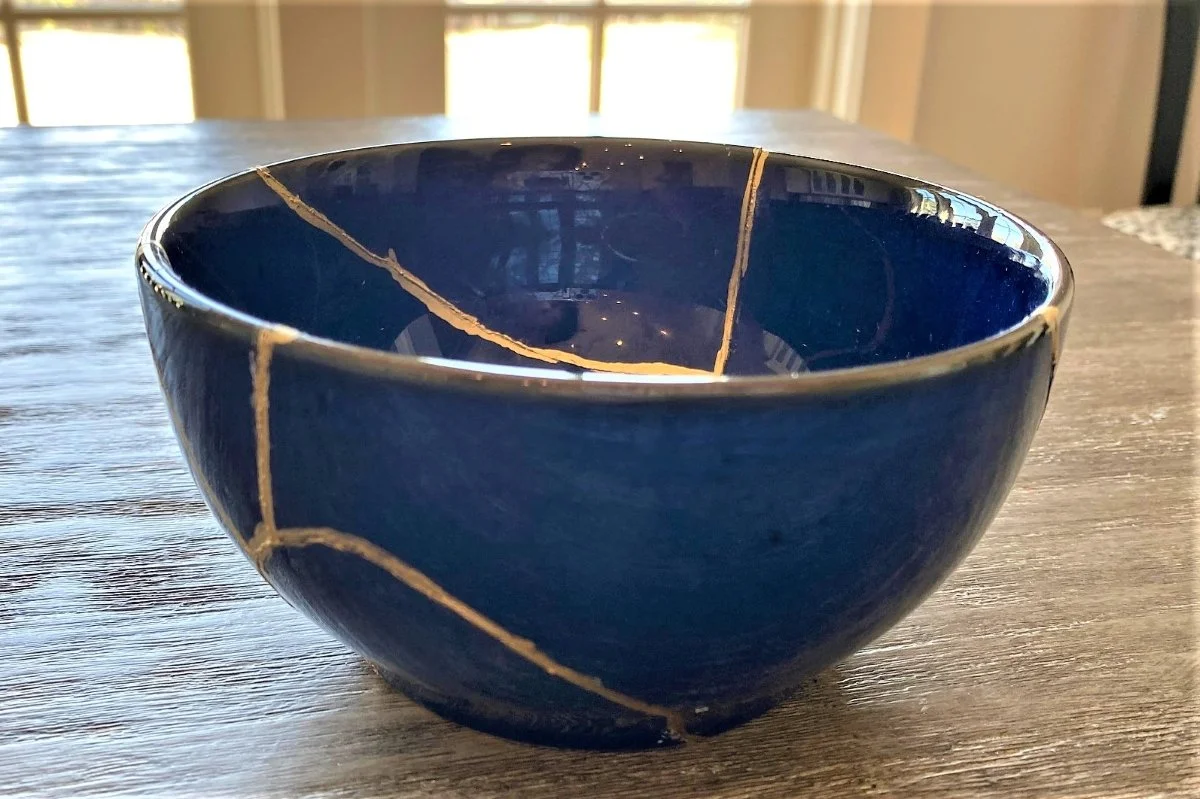Kintsugi: Beauty in the Broken
Kintsugi.
There is beauty in the broken.
Kintsugi is a Japanese art that repairs broken pottery with gold, rendering a new piece that is more exquisite than it was before the break. It literally means to join with gold.
I first read about kintsugi in Dave Furman’s book, Kiss the Wave and then again in Suffer Strong, by Katherine and Jay Wolf. I was fascinated by this art, and all it represented. Jay Wolf says:
“The story of kintsugi—this style of pottery—may be the most perfect embodiment of all our trauma-shattered lives... Instead of throwing away the broken beloved pottery, we’ll fix it in a way that doesn’t pretend it hasn’t been broken but honors the breaking—and more so, the surviving—by highlighting those repaired seams with gold lacquer. Now the object is functional once again and dignified, not discarded. It’s stronger and even more valuable because of its reinforced, golden scars.”
Rather than trying to hide the damage, kintsugi highlights the repair. The imperfections are what make it beautiful and valuable. A broken piece that is put back together has more of a story, seems more authentic and real, is stronger and more resilient than something that has stayed pristine. The breaking of what once was, the layered and time-consuming process of putting it back together, the mending it with gold, all contribute to its value. And surprisingly, it becomes more resilient after it has been mended by kintsugi, even stronger than it was before.
God is the restorer, the kintsugi Master who skillfully and tenderly puts the broken pieces of our lives back together. It takes time. I think of the gold resin as reading the Bible and praying, the two things that God used to cement my faith and make it stronger and more resilient.
Since I loved all that kintsugi represented, I asked my husband Joel to get me a kintsugi bowl or vase for my birthday. When I realized that authentic kintsugi was very expensive, even for a small piece. I insisted that an imitation would do. Then I decided to make it myself since I wouldn’t mind breaking a dish for the cause.
I found some do-it-yourself instructions on how to make faux kintsugi online and laughed at some of the comments people posted in response. One man said it seemed like it defeated the real meaning behind kintsugi to deliberately break something in order to put it back together. He had a good point, but I pressed ahead, nonetheless.
A friend came over and helped me with the whole process of breaking the dish, which was much trickier than you’d think, and super gluing it back together. Ironically, I wanted to make my bowl look perfect and I wasted a lot of valuable energy afterwards trying to clean up the edges and make the gold lines I painted look authentic. I laughed at myself when I realized this bowl (that’s pictured) was supposed to represent embracing my imperfections- but I wanted to make those look good too. I wanted my curated imperfections to show, not the real ones. Clearly, I have a long way to go!
After I was finished, I was strangely sad as I stared at my piece on the shelf. I realized I was mourning some of what had broken in my life. I used to be able to do almost anything artistic or crafty, and I could have easily done that project alone and made it look more real. But this time I needed help for every step of it. While I was so grateful for my friend’s help, I wished I could have done it by myself.
In some ways it was easier to give up the big things that I once did, like walking to work or renting a third-floor downtown apartment or living independently, but it’s the small things that I grieve the most. They are perhaps insignificant to others, but they are parts of what once defined me, that don’t anymore.
When a friend asked me to do an “artist interview “ for her blog last year, and I told her that it was hard to answer her questions because I didn’t see myself as an artist anymore. Her response has stayed with me: “Even though I know you can’t do what you once did, I see you as an artist by the way your house is decorated, the way you dress and the way you look at things. Being an artist is not really about what you do – being an artist is who you are.”
I teared up at her words because I had to surrender a big part of myself when I gave up watercolor painting, jewelry making, scrapbooking, painting dishes, cross stitching, and other crafts. I rarely feel like an artist anymore.
I try not to dwell on the things that I can’t do because there are many things that I still can do. The polio clinic said 20 years ago that if I didn’t stop all my artistic activities, in ten years someone would be feeding me. As a bona fide foodie, I’m happy to report I can still feed myself for now.
My friend Jeanne, who has ALS, finds more joy in helping others than anyone I’ve ever known. And she’s exceptionally creative and can see beauty in things other people pass by. Years ago, she dragged a large piece of driftwood from the beach, and it became the mantle in their home. It looked incredible. When we talk, often she mourns those losses. Her creativity and love for making spaces beautiful, which she could imagine and then make happen, lives only in her mind now. She loved serving others and now she is served for the simplest of everyday tasks. She misses those things that once defined her.
But in her I can see the whole principle of kintsugi so clearly. Her body is broken and failing, and she can’t do what she once did. Yet her spirit is more beautiful, and the daily struggles she lives with help the rest of us see God more clearly.
I love this quote from Furman’s book:
“Similar to the Japanese art of Kintsugi, our rough edges and cracks are filled in with gold to point to the greatness of God… We can embrace God in our trials with faith that God is doing a work in us beyond our comprehension. Our scars are not things to run from or to hide from others. Through them we exalt the one who is conforming us more and more into the image of Christ.”
As I look at the kintsugi piece I’ve made, I think about my losses, my friend Jeanne, and everyone whose lives feel imperfect and broken.
I am reminded of 2 Corinthians 4: 7-10 which says, “But we have this treasure in jars of clay, to show that the surpassing power belongs to God and not to us. We are afflicted in every way, but not crushed; perplexed, but not driven to despair; persecuted, but not forsaken; struck down, but not destroyed; always carrying in the body the death of Jesus, so that the life of Jesus may also be manifested in our bodies.”

